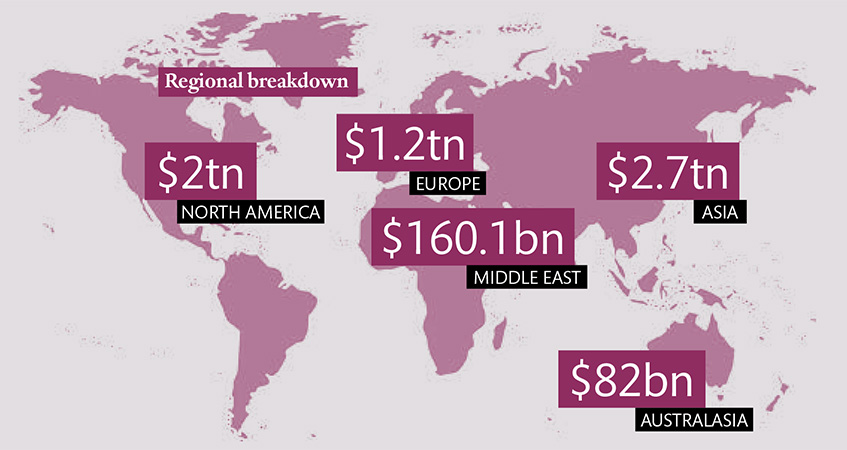In the contest to see who can own the biggest global real estate portfolio, the battle of the giants continues – with the US and China now almost level-pegged in EG’s Global 100 ranking. Together, Chinese and US-based real estate businesses own a whopping $3.4tn of assets – well over half of the total portfolio value of the world’s 100 biggest property owners
The world’s top 100 real estate companies now own more than $6tn of assets, according to EG’s annual Global 100 list.
The list, based on publicly available data on assets under management, is now in its seventh year and continues to see the value of the top 100 grow. This year’s figure of $6.1tn is some 11% higher than last year’s total. However, this does represent a slowdown in value growth: 2019’s total was some 20% higher than 2018’s.
US and Chinese property companies now own almost the same amount of global real estate by value, with the 27 US real estate companies in the top 100 owning a combined $1.75tn and the 20 Chinese companies in the list owning $1.69tn. Together, the two countries represent 56.2% of the total value of the top 100.
There was change in the top 10 this year, with only the top two biggest owners of real estate – China’s Evergrande Real Estate ($273.8bn) and Canada’s Brookfield Asset Management ($256.3bn) – retaining their positions. US-based PGIM Real Estate entered the top 10, moving from 11th position in 2019 to eighth this year, with $153.9bn of assets under management. It pushed Met Life Investment Managers from 10th place to 11th.
There was also some jostling for position among the Chinese giants this year, with Country Garden Holdings leapfrogging China Vanke to take third position in the ranking. Country Garden’s AUM rose from $161.2bn in 2019 to $237.4bn in this year’s list – a 47% increase – while China Vanke saw its AUM increase by 14% to $222.6bn.
Sovereign wealth funds in real estate: fewer but stronger
At the beginning of 2020, sovereign wealth funds represented just 1% of investors in real estate, down from 3% in 2019, writes Tom Carr, head of real estate, Preqin. But despite the decline, SWFs remain very influential and are among the largest investors in the asset class.
For the first time, a Chinese sovereign wealth fund has gone to the top of the list. China Investment Corporation is the largest sovereign wealth fund investor in the asset class, with an allocation of $53bn – a big increase of capital allocated within a short period of time. Last year, CIC had $24.9bn allocated to real estate.
Not far behind CIC is the Abu Dhabi Investment Authority, which has a current allocation of $52bn; while in third is the Investment Corporation of Dubai, allocating $42bn. These SWFs are based in the United Arab Emirates, which means two of the three largest SWFs investing in real estate are based in that region – a sign of the country’s commitment to real estate as part of its overarching investment strategy.
With interest rates so low across most developed markets, SWFs recognise the potential benefits afforded to them through exposure to real estate: portfolio diversification, hedging against inflation and high risk-adjusted returns.
The average commitment size of sovereign wealth funds is $136m, the largest size of all investor types. However, as with most other investors, they are generally below their target allocations; while they seek to commit an average of 10% of their assets, their current median allocation is just 7%. As a result, we may well see further increases in activity over the next few years.
Looking at preferred strategies, based on our latest survey, 83% of SWFs have appetite for co‑investment opportunities or would be considering co-investing in their fund commitments; 72% of them are investing via separate accounts and 11% are considering doing so.
To send feedback, e-mail samantha.mcclary@egi.co.uk or tweet @samanthamcclary or @estatesgazette












